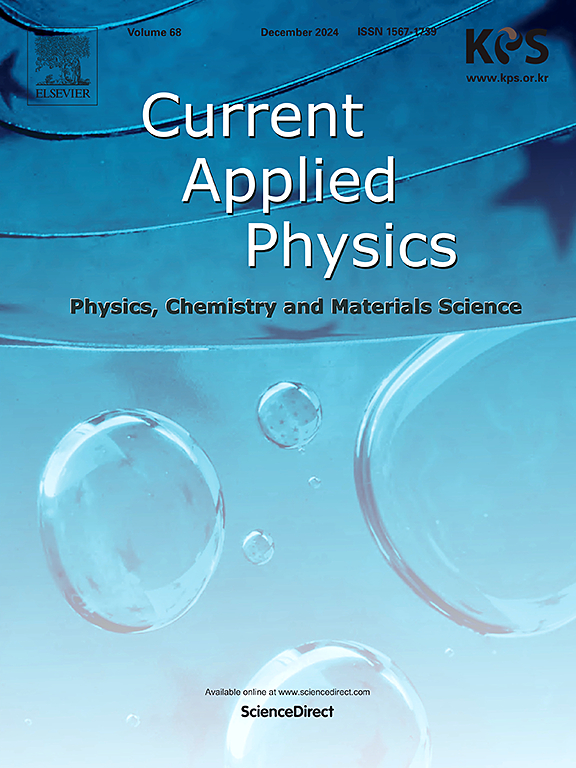Polythiophene nanostructure film deposited using a bump electrode in atmospheric pressure plasma polymerization for increased film uniformity
IF 2.4
4区 物理与天体物理
Q3 MATERIALS SCIENCE, MULTIDISCIPLINARY
引用次数: 0
Abstract
We propose a plasma reactor with a multiple bump-shaped wire electrode to increase the plasma volume for atmospheric pressure (AP) plasma polymerization. Triangular bumps are added to the tungsten wire in a plasma reactor in the form of a vessel capable of generating plasma. Since the discharge is initiated and maintained at the lower part of the triangular bump electrode, the effective volume of the glow plasma can be increased as the number of bumps increases. Even though a discharge imbalance due to differences in bump positions can adversely affect the uniformity of polymerized films, rotating the substrate can greatly improve film uniformity. With the developed AP plasma reactor, polythiophene (PTh) nanostructure films are synthesized and both the film characteristics and uniformity of the PTh nanostructures are investigated in detail. Additionally, conductive PTh films are produced through an iodine doping process, and the chemical properties and electrical stability of the doped PTh films are thoroughly examined.

在常压等离子体聚合中采用凹凸电极沉积聚噻吩纳米结构薄膜,以提高薄膜的均匀性
为了增加常压等离子体聚合的等离子体体积,我们提出了一种带有多个凸形丝电极的等离子体反应器。在等离子体反应器中,以能够产生等离子体的容器的形式在钨丝上添加三角形凸起。由于放电是在三角形凹凸电极的下部开始并维持的,因此发光等离子体的有效体积可以随着凹凸电极数量的增加而增加。尽管由于凹凸位置的不同而导致的放电不平衡会对聚合膜的均匀性产生不利影响,但旋转衬底可以大大改善膜的均匀性。利用研制的AP等离子体反应器合成了聚噻吩(PTh)纳米结构薄膜,并对PTh纳米结构的薄膜特性和均匀性进行了详细的研究。此外,通过碘掺杂工艺制备了导电PTh薄膜,并对掺杂PTh薄膜的化学性质和电稳定性进行了全面研究。
本文章由计算机程序翻译,如有差异,请以英文原文为准。
求助全文
约1分钟内获得全文
求助全文
来源期刊

Current Applied Physics
物理-材料科学:综合
CiteScore
4.80
自引率
0.00%
发文量
213
审稿时长
33 days
期刊介绍:
Current Applied Physics (Curr. Appl. Phys.) is a monthly published international journal covering all the fields of applied science investigating the physics of the advanced materials for future applications.
Other areas covered: Experimental and theoretical aspects of advanced materials and devices dealing with synthesis or structural chemistry, physical and electronic properties, photonics, engineering applications, and uniquely pertinent measurement or analytical techniques.
Current Applied Physics, published since 2001, covers physics, chemistry and materials science, including bio-materials, with their engineering aspects. It is a truly interdisciplinary journal opening a forum for scientists of all related fields, a unique point of the journal discriminating it from other worldwide and/or Pacific Rim applied physics journals.
Regular research papers, letters and review articles with contents meeting the scope of the journal will be considered for publication after peer review.
The Journal is owned by the Korean Physical Society.
 求助内容:
求助内容: 应助结果提醒方式:
应助结果提醒方式:


